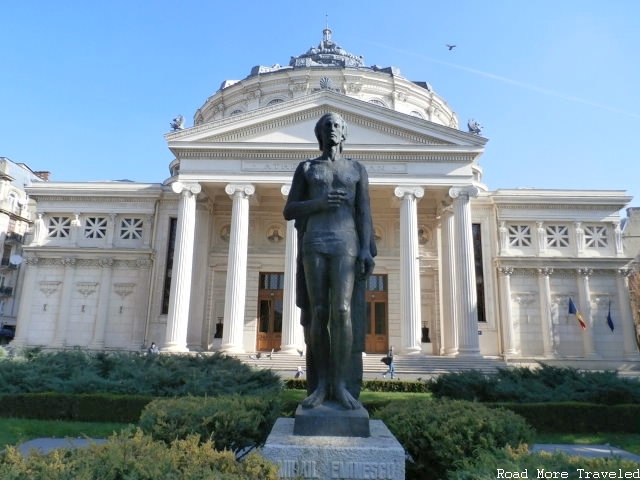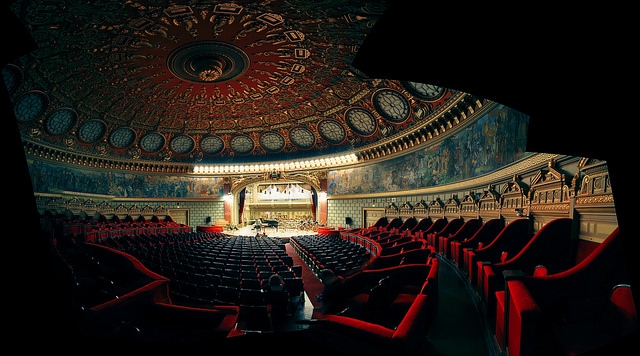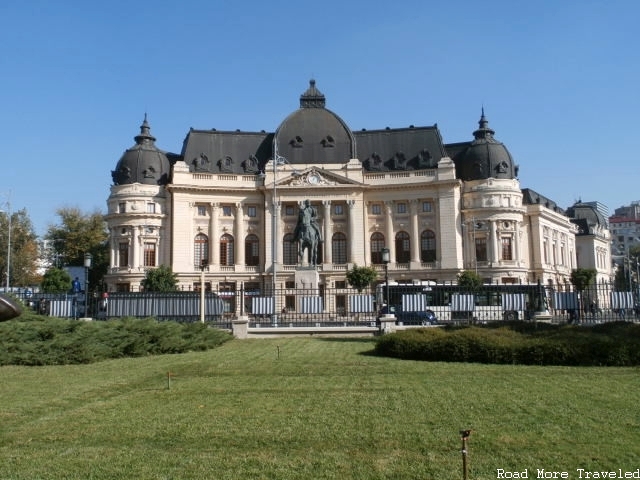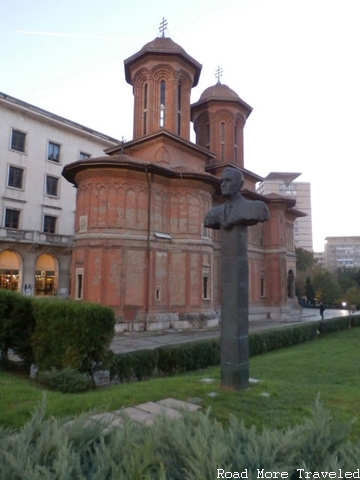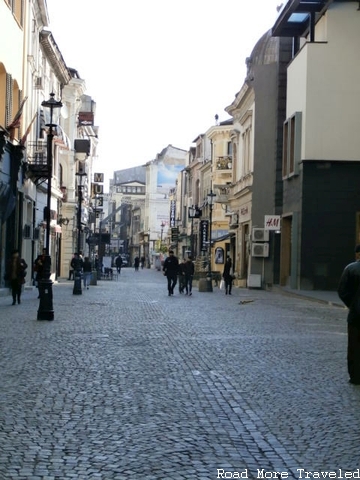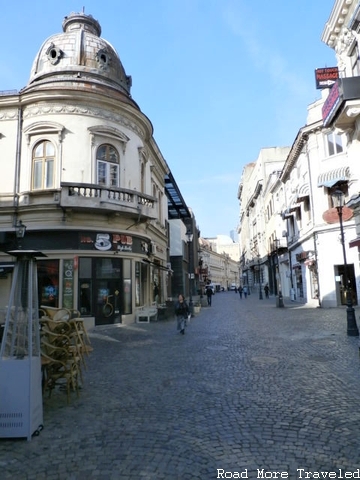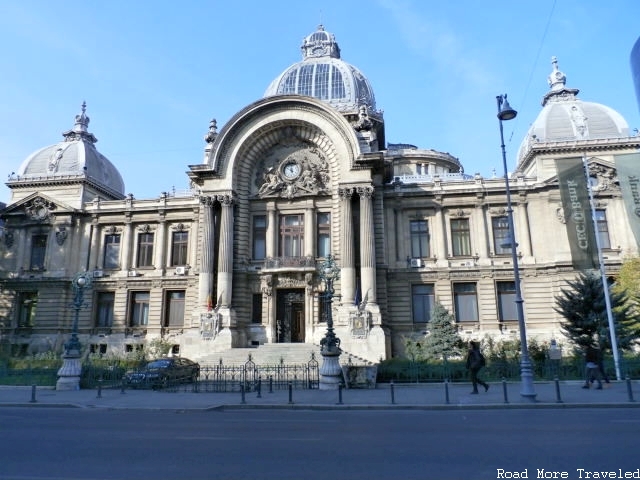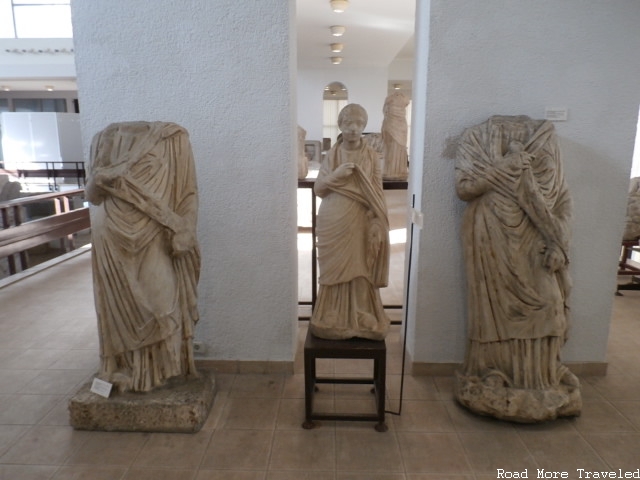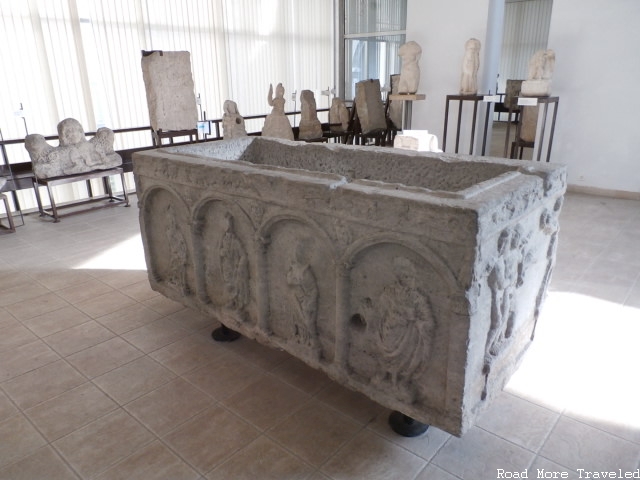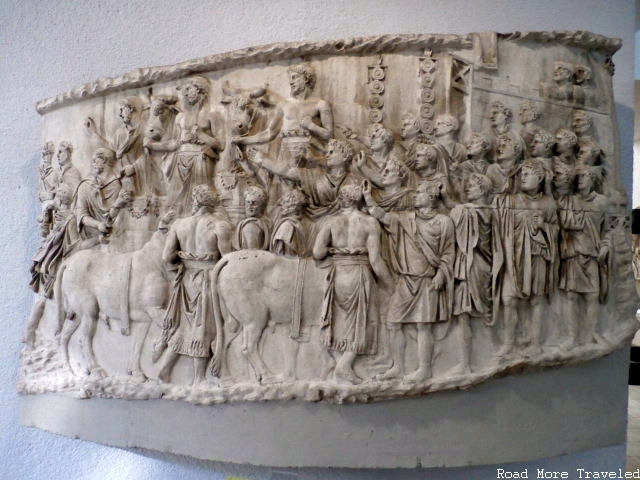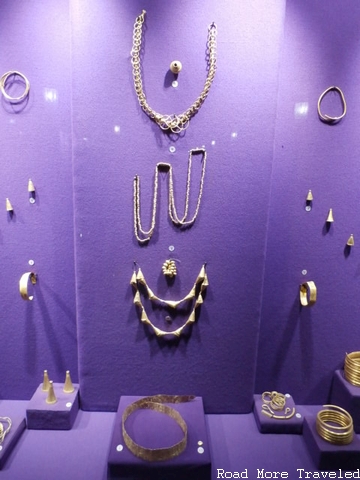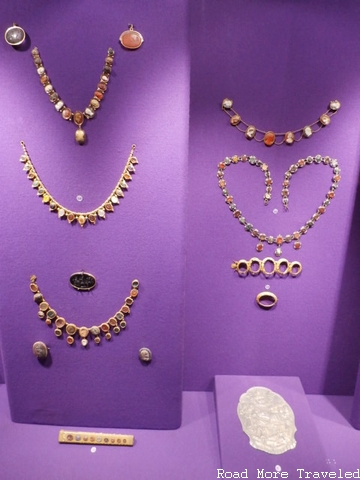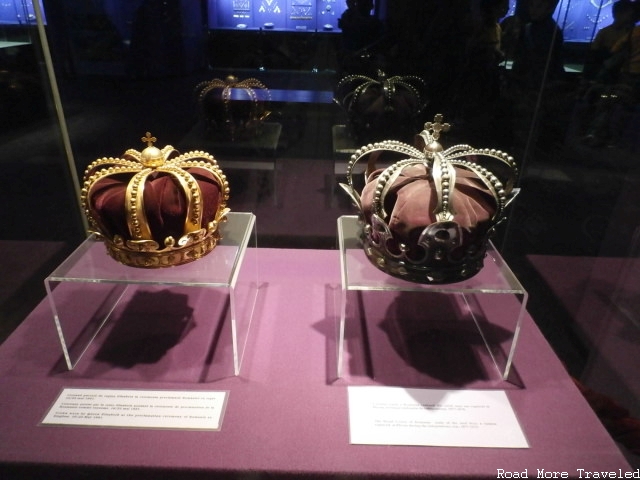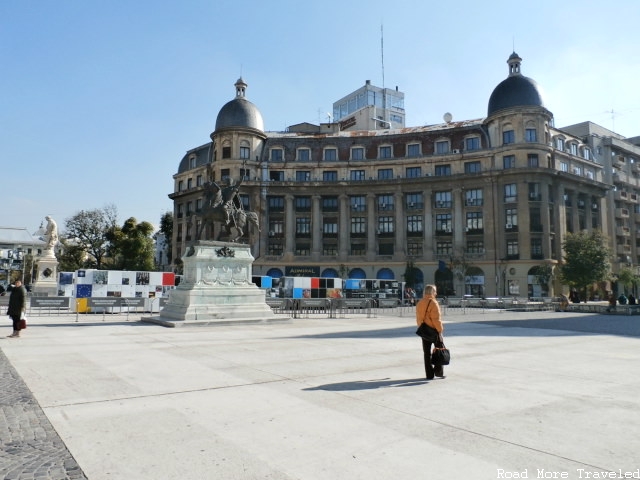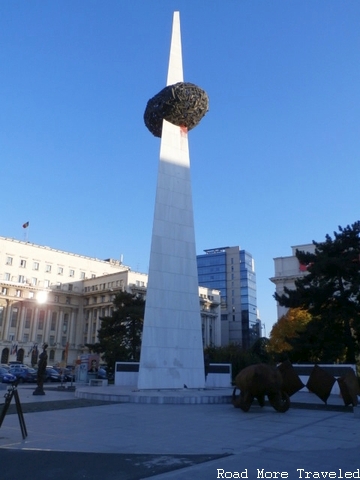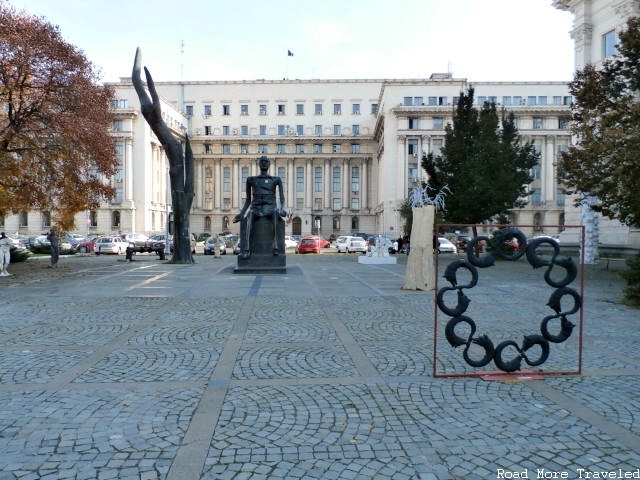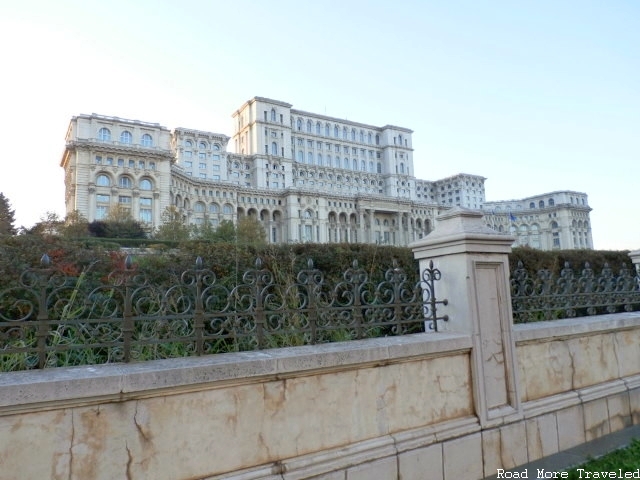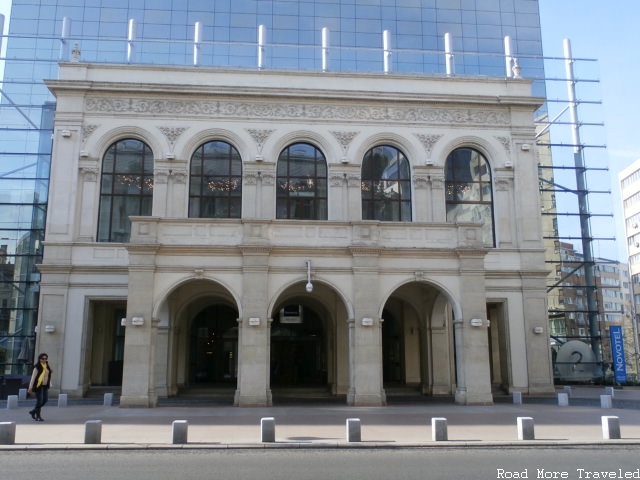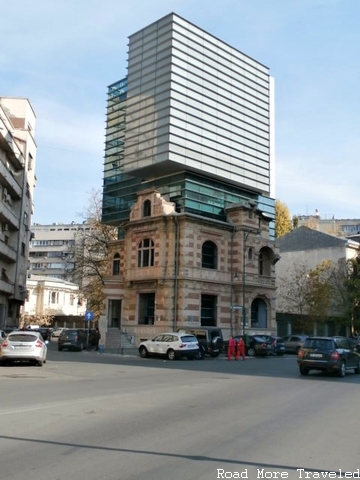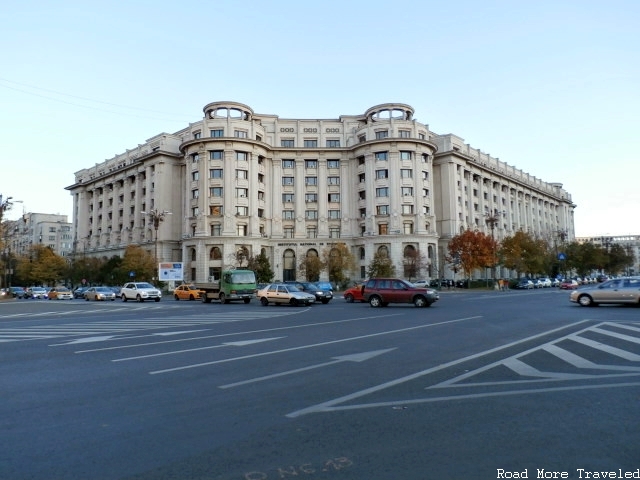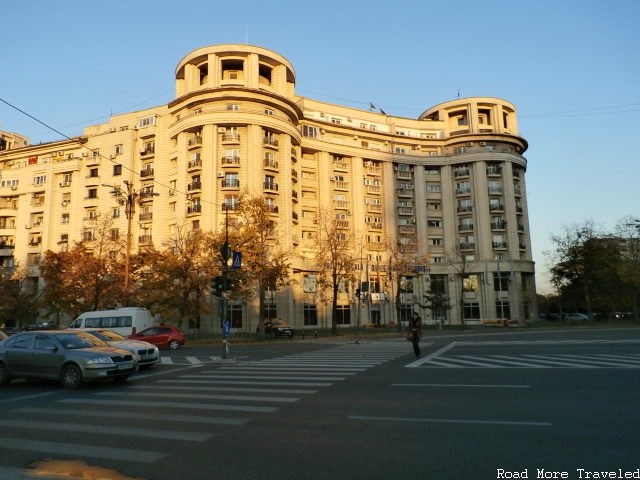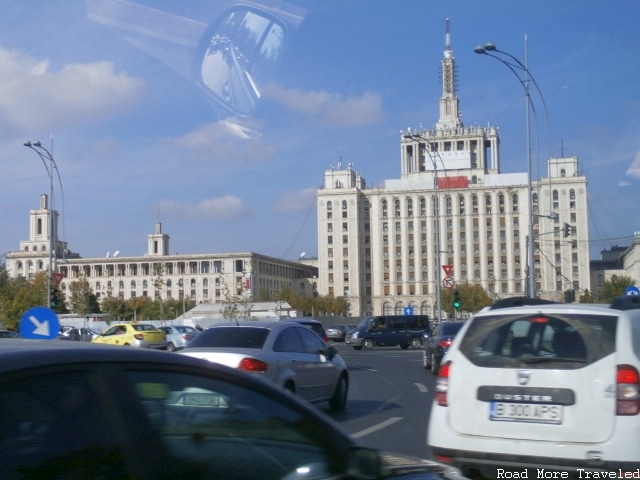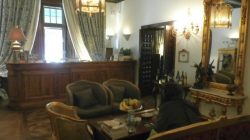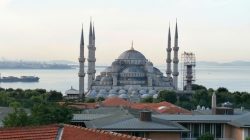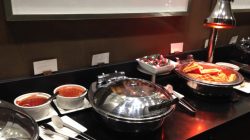Though we came to Romania to visit Transylvania, we did have a day and a half in Bucharest on either side of that adventure. Bucharest (București) is a metropolis of roughly 2 million people and the 6th largest city in the EU, but is actually relatively “new” by European standards. It is believed to have been formally settled in the mid-15th century, but didn’t become the capital of Romania until 1862. The city enjoyed its heyday between the First and Second World Wars, earning the nickname “Little Paris” due to its beautiful architecture and sophistication. World War II heavily damaged the city, however. Thereafter, the “systematization” program of Communist dictator Nicolae Ceaușescu added a layer of sterility to the mix. The result is an interesting mix of Old World Romania, cookie cutter Communist-era, and modern all wrapped into one.
First, a couple of notes about our trip to Bucharest in general. We wanted to see a couple of museums, but otherwise, we really just walked around the city checking out the place and enjoying its large parks. I realize this isn’t going to be everyone’s idea of a good time, but it was by design. First, our 1 A.M. arrival into Bucharest from Prague left us really tired on our first day. Meanwhile, the last would only be a half day as we had a 3 P.M. flight out of town. That, and for us architecture and history buffs, the mix of new and old was just fascinating to see.
Getting Around Bucharest
I found Bucharest incredibly easy to navigate on foot, especially when staying near the city center. Everything we visited is a 30 minute walk or less from our hotel just north of the city center. There is also a reasonably extensive bus and Metro system, and the Metro in particular is ridiculously cheap. An all-day pass is just 8 lei (~$2). Be aware, however, that signage tends to be poor, and the system stops running at 11 P.M. And, there is no line running directly to the airport (yet). Getting around by road, however, can be difficult, as Bucharest traffic borders on nightmarish, especially during rush hours. On our way back from Bran, for example, we ended up asking our tour guide to let us get off about 1/2 mile from our hotel, as it took nearly 20 minutes just to crawl that distance in the car.
Also, a warning about using your ATM card to get cash. Apparently, banks consider Romania a high risk location for debit card fraud. Thus, they could block withdrawals, even if you provide a travel notification. This happened to me. Twice, on the same morning, which annoyingly was the first morning of our stay. I had to run back to the hotel and call the bank via Vonage. But the bank blocked my next attempt anyway, requiring yet another call. Of course, it was all “for my protection”. Anyway, the good news is that foreign exchange booths charge reasonable fees, usually only 1-1.5%. Anyway, I suggest carrying some dollars or euros, just in case your bank does block your card. (Most establishments in the city do accept credit cards, though you’ll need cash for museum tickets and such.)
I’ll start off with…
The Old
Sadly, World War II and the Ceaușescu administration destroyed many of Bucharest’s historic buildings, but several fine examples remain standing. The point of interest closest to our hotel, the Hotel Scala, is the impressive Romanium Athenaeum (Ateneul Român), just a 5 minute walk to the west.
I initially mistook this for a government building or palace. It is actually a concert hall, home to the George Enescu Philharmonic. The Athenaeum actually isn’t that old, having opened in 1888. But its ornate design makes it perhaps the single most recongized landmark in Bucharest, and it did play an important part of Romanian history. It was here, on December 29, 1919, that the unification of what were then four separate republics into what is now Romania, was ratified. The Athenaeum is also renowned for the stunning fresco lining the circular war of the concert hall. Unfortunately, though, the building did not appear to be open to the public outside of performance hours. But, thanks to Flickr Creative Commons, I found an interior photo to give you a taste of the fresco.
Just down the street is the Central University Library of Bucharest. It’s an ordinary library on the inside, but opened in 1895, is another beautiful example of the classical architecture common in Bucharest. Protesters started a fire in the building during the Romanian Revolution of 1989, closing it for more than ten years. It is fully restored to its former grandeur today.
A little further south on the famous Calea Victoriei, and across the street from Revolution Square, is the Kretzulescu Church (Biserica Creţulescu), an Eastern Orthodox church dating to the early 1720s.
Ceaușescu earmarked the church for destuction, but thankfully it escaped the wrecking ball. The church is known for its distinctive, narrow bell towers, along with the exposed exterior brick which gives it its reddish appearance. The statue in front is of Corneliu Coposu, a political dissident during Communist rule. He was also one of the leaders of the Romanian Revolution.
That rounded out the “old” for our first day in Bucharest. On the morning of our second (actually our third day in Romania), we started off our day by taking a leisurely stroll down the Strada Lipscani.
“Lipscani” literally translates to “trader who brought his wares from Western Europe”. As you might guess, it was Bucharest’s original commercial district. In addition, the street is loosely believed to be located where Bucharest was originally founded. Vlad Ţepeş, aka Vlad the Impaler, constucted a royal palace and court in the vicinity. Today, Lipscani is the heart of Old Town Bucharest, the place to go for shopping, restaurants, nightlife, etc. And, walking the cobblestone streets among the historic buidings really is like a walk back in time. The Ceaușescu regime also intended to raze Strada Lipscani, but it too avoided the wrecking ball. Luckily, it also lived to see another day after the fall of the Communist government.
Back on Calea Victoriei is another important Bucharest landmark, the CEC Palace (Palatul C.E.C.).
The building isn’t a palace, though. It’s the headquarters building for CEC Bank. The bank actually sold the building to the municipality of Bucharest. The city intended to transform the building into a museum. As of today, however, the bank still rents the building for use as its headquarters. The building features two distinctive features – the double columns at the main arch entrance, and the glass dome up top. It is also said that the building is one of the few “earthquake proof” buildings in Bucharest. You’ll also find several buildings in the older part of the city with a similar “double column” design.
Across the street is an attraction you really need to make time for if you’re a fan of history and musems, the National Museum of Romanian History. For an entrance fee of 25 lei (~$6), you get access to a series of exhibits detailing Romania’s Communist period, numerous ancient Roman artificats recovered from across the country, and the country’s treasury of crown jewels. Definitely worth the price of admission.
That was about it for the old, so now moving on to…
The New
The “new” in Bucharest tends to be quite interesting. Instead of being totally “new”, it is typically an overlay of something new onto something of Bucharest’s past. You’ll see what I mean, especially with a couple of the later examples.
On our first day, as I was searching for a foreign exchange booth thanks to my ATM card not working, we stumbled upon a free history exhibit just outside the Romanian Commercial Bank building in front of the University of Bucharest (the posters up in front of the building).
The exhibit combines describing the darker side of Romania’s Communist era, along with the struggle for independence and eventually the coming of the Romanian Revolution. It’s a powerful exhibition, especially for someone like me who was still in grade school when the Berlin Wall fell. Thus, I didn’t have a complete appreciation for life in Eastern Europe during that time period. It’s pretty clear there isn’t much nostalgia for the Ceaușescu regime in Romania. Again, the open-air exhibition is free, and something I definitely recommend for city visitors.
A little farther north on Calei Victoriei is Revolution Square (). Here, on December 21, 1989, tens of thousands of protesters gathered for a rally against President Nicolae Ceaușescu. Ceaușescu planned a counter-rally, but things didn’t turn out according to plan. Though the police ruthlessly crushed the protest, killing more than 1,000 protesters, Ceaușescu lost the crowd. Yes, even the counter-protesters he brought in. This forced Ceaușescu into exile, ending Communist rule in Romania. Today, the square is home to the “Memorial of Rebirth”, a symbol of the country’s rebirth after the fall of Communism, as well as several pieces of modern art. The building in the background is the old Senate building. Ceaușescu stood on the balcony of this building to attempt to shout down the protesters. Ultimately, he was forced to helicopter to safety from the railing as the crowd turned against him.
The Memorial of Rebirth
Modern art throughout the square
Probably the best-known “new” building in Bucharest is the Palace of Parliament, once known as “The People’s Palace”.
You might think this is actually an old building based on its design, but in fact, it opened in 1984. The building is absolutely enormous, housing more than 3,000 rooms and covering 330,000 square meters. That makes it the second largest administration building in the world, behind only the Pentagon. The palace was originally intended to be a vanity piece for President Ceaușescu. In a twist of irony, however, he was deposed before it could be completed. Even today, though many administrative functions of the Romanian central government are maintained here, much of the palace remains unused. You can take a guided tour, but these must be arranged in advance, and unfortunately, our short stay didn’t leave enough time. You can pre-arrange a tour yourself online, but annoyingly, you must call to confirm between 10 and 4 the day before your tour, or your order will be canceled.
The last two examples of “new” are good examples of the juxtaposition of new and historic that I’d alluded to earlier. The first is the Novotel Bucharest City Centre hotel, featuring a historic facade fronting a very modern hotel building.
The second is a modern office building near the Romanian Athenaeum, a rather odd structure where a modern tower appears to have been literally plopped down on top of an early 20th-century building.
It’s an illusion of course. The modern building is, in fact, behind the old one. But you see lots of these kinds of odd combinations throughout the city.
And that finally brings us to…
The Ugly
As is the case in many former Communist Bloc countries, you’ll find a lot of ugly buildings in Bucharest, and throughout Romania for that matter. The exact reasons differ, but in Romania’s case, among President Ceaușescu’s many faults, he was infamously a man of horrible taste. He hated classical/historical architecture, and one of his goals was to tear down the country’s historic palaces and buildings and replace them with “modern” structures in a program called “systematization”. The general idea was to give everything the sterile, cookie-cutter feel of Communist-era architecture from the 1950s. And so, especially near the Palace of Parliament, you see rows and rows of buildings that look identical to these.
Looked at in a vacuum, you could say these buildings are simply pretty plain, kind of like Weird Al Yankovic’s life in “Amish Paradise”. But when you see blocks and blocks of buildings that look just like this – yeah, it’s ugly. But I’d have to see it’s this building that takes the cake.
This is the House of the Free Press (Casa Presei Libere), a building constructed in the 1950s to house the state-run press apparatus. Its design is based on the main building at Moscow State University in Russia, in a style known as Soviet Socialist realism. I’d say it captures the sterility of Communist-era architecture nearly perfectly. It’s definitely ugly, though also unique, a throwback to Eastern Europe’s Cold War period. A statue of Lenin used to be located at the front of the building, but it was removed after the Romanian Revolution. And in perhaps the ultimate middle finger to the Communist era, the building still houses offices of many of the city’s (now free) newspapers. NOTE: this building is not walking distance from the city center. If you’d like to explore this part of town, take the Metro to Aviatorilor station, then walk northwest through the lakeside park.
Next week, we head north to see the entire purpose of our trip – a road trip to Transylvania, and two of its fabulous royal castles.
This post is part of my trip report series about our trip to the Czech Republic and Romania in October. Click here for the introductory post and trip report index.
Photo of the interior of the Romanian Athenaeum: Bucharest – Romanian Athenaeum, by fusions-of-horizons, via Flickr Creative Commons, license Attribution 4.0 International (CC BY 4.0)


